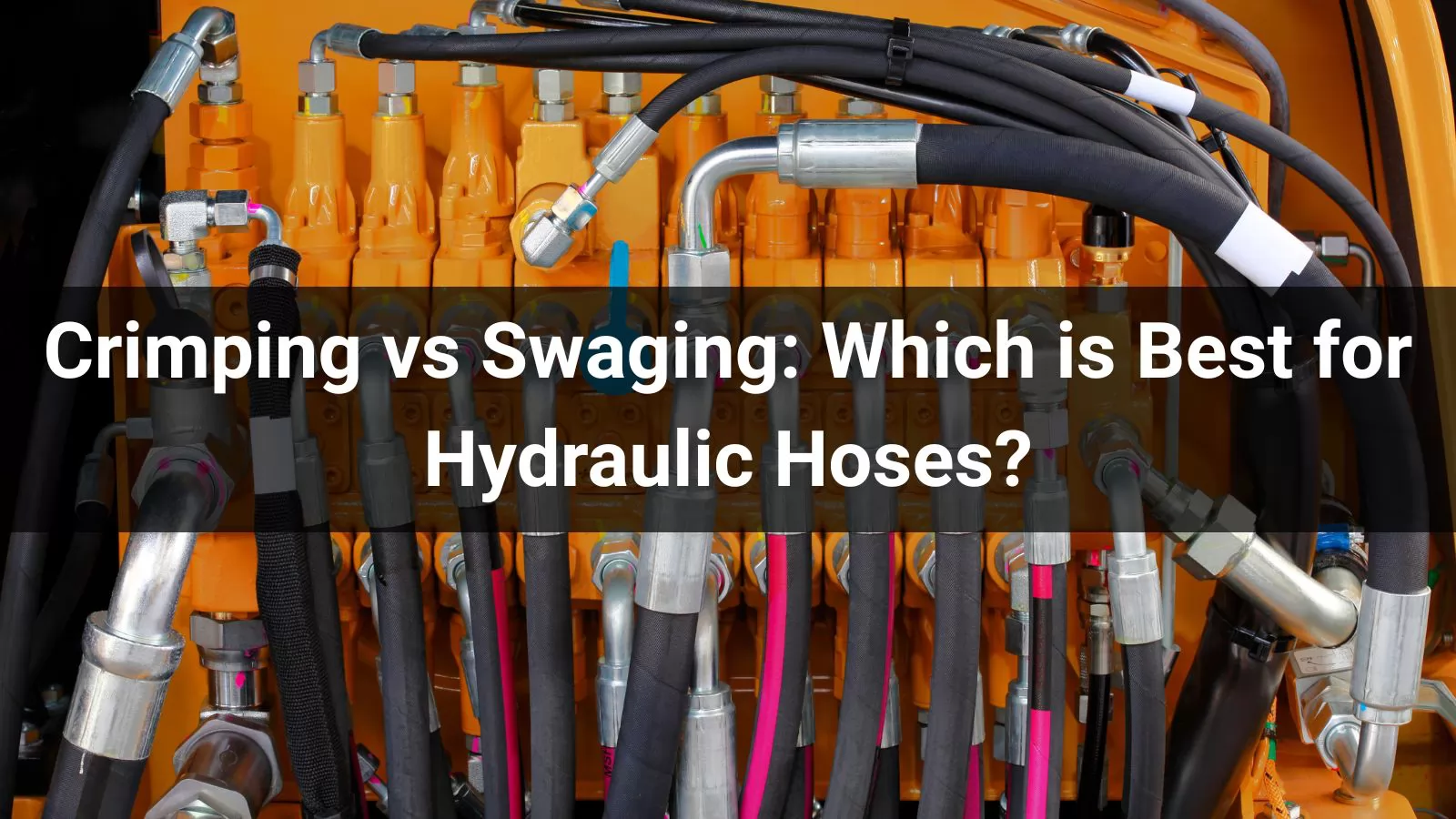Crimping vs Swaging: Which is Best for Hydraulic Hoses?

Introduction
In the world of hydraulic systems, securing hoses to fittings is critical for safety, performance, and durability. Two primary methods dominate the industry: crimping and swaging. But what’s the difference, and which one is right for your project? Whether you’re assembling hydraulic hoses for heavy machinery, automotive systems, or industrial applications, understanding these processes can save you time, money, and maintenance headaches. In this comprehensive guide, we’ll compare crimping and swaging, explore their applications, and provide expert tips to help you choose the best method for your needs.
What is Crimping?
Crimping is a metal-forming process that uses a crimping machine to compress a ferrule or sleeve around a hose and fitting. The machine applies uniform pressure across the entire circumference of the ferrule, creating a permanent, leak-proof connection. Crimping is widely used in industries like hydraulics, automotive, and construction due to its reliability and ability to handle high-pressure applications.
Key Features of Crimping:
- Process: A crimping tool or machine uses segmented dies to compress the ferrule in a single, simultaneous action.
- Applications: Ideal for hydraulic hoses, pneumatic systems, and automotive fuel lines.
- Equipment: Ranges from handheld crimpers for small jobs to automated machines for high-volume production.
What is Swaging?
Swaging is a forging process that reduces the outer diameter of a ferrule by pushing it through a fixed die. This compresses the hose into the fitting’s stem serrations, forming a strong, seamless connection. Swaging is often preferred in industries like oil and gas, aerospace, and marine applications due to its durability and smooth finish.
Key Features of Swaging:
- Process: The hose and fitting are gradually pushed through a die, reducing the ferrule’s diameter progressively.
- Applications: Common in high-pressure systems, wire rope assemblies, and chemical processing.
- Equipment: Requires specialized swaging machines, which can be manual, hydraulic, or pneumatic.
Crimping vs Swaging: A Detailed Comparison
| Aspect | Crimping | Swaging |
|---|---|---|
| Process | Compresses the ferrule uniformly using segmented dies in one action. | Gradually reduces ferrule diameter by pushing through a fixed die. |
| Force Required | High force due to simultaneous compression. | Lower force, applied progressively. |
| Connection Strength | Strong, but less suited for extreme pull-force applications. | Extremely strong, ideal for heavy-duty applications like wire ropes. |
| Equipment Cost | Expensive for automated crimpers; handheld options are affordable. | Higher initial cost for swaging machines. |
| Ease of Use | Faster for small-scale or automated setups. | Slower, requires precise setup and skilled operation. |
| Applications | Hydraulic systems, automotive, construction. | Oil and gas, aerospace, marine, chemical processing. |
| Appearance | Bulkier due to ferrule deformation. | Seamless, smooth finish with no protrusions. |
| Reusability | Permanent; requires cutting and replacing for repairs. | Permanent; field repairs are challenging. |
Advantages and Disadvantages
Crimping
Advantages:
- Speed: Faster for high-volume production, especially with automated crimpers.
- Versatility: Works with a wide range of hose materials (rubber, thermoplastic, metal).
- Cost-Effective for Small Scale: Handheld crimpers are affordable for DIY or small workshops.
Disadvantages:
- Higher Force Requirement: Requires more powerful equipment for heavy-wall ferrules.
- Limited for Extreme Applications: Less suited for ultra-high-pressure or weight-bearing systems.
- Aesthetics: Crimped connections may appear bulkier.
Swaging
Advantages:
- Superior Strength: Ideal for high-pressure and high-pull-force applications.
- Seamless Finish: Smooth connections reduce snagging and improve aesthetics.
- Chemical Compatibility: Preferred in industries requiring high cleanliness standards.
Disadvantages:
- Higher Costs: Swaging machines are expensive, especially for small businesses.
- Limited Field Repairs: Permanent connections make on-site repairs difficult.
- Complex Setup: Requires skilled operators and precise equipment calibration.
Applications of Crimping and Swaging
Crimping Applications
- Hydraulic Systems: Used in construction equipment, manufacturing machinery, and automotive hydraulics for reliable, leak-free connections.
- Automotive: Common in fuel lines, brake systems, and air conditioning hoses.
- Pneumatic Systems: Secures hoses in industrial air supply systems.
Case Study: A construction company reduced downtime by 15% by using crimped hydraulic hoses for their excavators, thanks to the quick assembly and reliability of crimping.
Swaging Applications
- Oil and Gas: Preferred for rotary hoses on oil rigs, handling pressures up to 5,000 psi.
- Aerospace: Used in aircraft control cables and safety harnesses for their strength and precision.
- Marine: Common in rigging equipment and cable railings due to corrosion-resistant fittings.
Case Study: A marine engineering firm switched to swaged fittings for their yacht rigging, improving safety and reducing maintenance costs by 20%.
Choosing the Right Tools
Selecting the right tools depends on your budget, application, and production scale. Here are some recommendations:
- Handheld Crimpers: Ideal for small-scale or DIY projects. Example: iCrimp Manual Crimping Tool ($100-$200).
- Hydraulic Crimpers: Best for high-volume production. Example: Gates Power Crimp 707 ($5,000-$10,000).
- Manual Swaging Tools: Suitable for small workshops. Example: iCrimp Manual Swaging Tool ($150-$300).
- Hydraulic Swagers: For heavy-duty applications. Example: Fenn-Torin Hydraulic Swager ($10,000+).
Tip: For budget-conscious users, renting high-end equipment for occasional use can be a cost-effective solution.
How to Choose Between Crimping and Swaging
Consider the following factors:
- Application Needs: High-pressure systems (e.g., oil rigs) favor swaging, while general hydraulics lean toward crimping.
- Budget: Crimping is more affordable for small-scale operations; swaging requires a larger upfront investment.
- Hose Material: Both methods work with rubber, thermoplastic, and metal hoses, but swaging excels with rigid materials.
- Maintenance Requirements: Crimped hoses are harder to repair, while swaged connections are permanent.
- Industry Standards: Check local regulations (e.g., ISO 6162 for hydraulic fittings) to ensure compliance.
Expert Advice: Consult with a hydraulic fitting supplier to match your tools and fittings to the specific media, pressure, and temperature of your application.
FAQ: Common Questions About Crimping and Swaging
Q: Can crimped hoses be reused or repaired?
A: No, crimped hoses form a permanent connection. Repairs require cutting off the crimped section and attaching a new fitting.
Q: Are swaged fittings compatible with all hose types?
A: Yes, swaged fittings work with rubber, thermoplastic, and metal hoses, but proper fitting selection and swaging technique are critical.
Q: Which is more cost-effective for small businesses?
A: Crimping is generally inductmore cost-effective due to lower equipment costs and faster assembly times.
Q: What’s the latest trend in crimping/swaging technology?
A: Automated crimping systems with PLC controls are gaining popularity for their precision and efficiency in high-volume production.
Conclusion
Choosing between crimping and swaging depends on your project’s specific needs, budget, and industry requirements. Crimping offers speed and affordability for general hydraulic applications, while swaging provides unmatched strength and a seamless finish for high-pressure systems. By understanding the technical differences, evaluating your application, and selecting the right tools, you can ensure safe, reliable, and cost-effective hose assemblies.
Ready to upgrade your hydraulic systems? Contact HGW Hydraulics for expert advice, high-quality fittings, and top-tier crimping/swaging tools. Visit our product page to explore our range or get a free quote today!
-
2024 Shanghai Bauma Exhibition China International Construction Machinery ExhibitionUpdate on 2024-12-25
-
2024 Las Vegas International Mining ExhibitionUpdate on 2024-12-25
-
Leading the High-End and Empowering the World | Bauma China 2024, Hgw Successfully ConcludedUpdate on 2024-12-25
-
Hgw's Multi-field Hydraulic Products Appeared at the Exhibition丨MINEXPOUpdate on 2024-12-25
-
2024 PTC ASIAUpdate on 2025-02-12
-
Top 10 Leading Hydraulic Fitting Companies in the WorldUpdate on 2025-02-27
-
Top 10 Global Suppliers of Hydraulic Hose FittingsUpdate on 2025-03-04
-
HGW's O-Ring Face Seal Fittings(ORFS): From Core to Best UseUpdate on 2025-03-08















